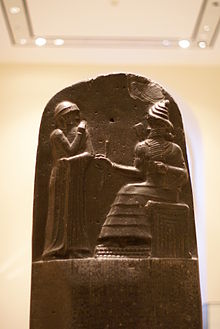Šamaš
Šamaš (shamash) was the sun god , god of justice and divination in Akkadian and Babylonian mythology . He corresponded to the god Utu of the Sumerians . Similar to the god Ninurta, there are indications that it was originally a female deity. Therefore, Šamaš can be called “mother” in name titles. It was not until the encounter with Sumerian culture at the beginning of the Akkad period and the equation of Šamaš with the Sumerian sun god Utu that the female sun became a male god. His symbol was the sun disk with mostly eight-pointed star and wave-shaped rays, sun rays on his shoulders, the lion and the saw. He is often portrayed climbing into the sky between the mountains, the saw in hand with which he made his way out of the mountains.

genealogy
Šamaš was the son of the moon god Nanna / Sin . With the goddess Aja (Anunitu), Šamaš fathered the sons Mešaru (Mišaru) and Kettu (Kittu), the personifications of law and justice and his constant companions. Other children are the dream gods Mamu and Ziqiqu (Sisig), as well as Išum with Ninlil .
history
Šamaš was never a major god in the Babylonian pantheon. Unlike other gods, he only appears in a few myths. His main sanctuary was the E-Babbar temple in Sippar , but there were also temples that he shared with other gods, e.g. B. the moon god Nanna in Aššur. As the sun god, who could see everything and defeat the darkness, he was also considered the god of justice and justice. Accordingly, Hammurapi had himself depicted on the famous legal stele, the Codex Ḫammurapi , as he received the symbols of rule from Šamaš, the god of justice. While Šamaš was considered a meek god in the Akkadian and Babylonian times, and only had special significance as a judge, Šamaš acquired a warlike character in Assyrian times and partly merged with the Assyrian god Aššur . In Greco-Roman times, Šamaš was popular among the Arab inhabitants of the Syrian oasis city of Palmyra . He was especially worshiped by tribe members of the Bene Zabdibol together with the Arab god Rahim in the temple of al-Lat , the "mistress of the temple". In Palmyra, Šamaš asserted his place next to the sun gods Jarḥibol and Malakbel, who were worshiped at the same time . Several tesserae depict Šamaš with the high god of Palmyra, Bel , which underlines his part in the official temple cult of Bel.
The root Š-m-š or Sms stands for "sun" in all Semitic languages, for example in Arabic شَمْس (shams) or in Hebrew שֶׁמֶשׁ (Schemesch)
mythology
Samaš stepped out of Mount Maschu every day and climbed the sky. Its rays of light penetrated everywhere, through which he recognized every secret and every wrongdoing. In the evening he went back into the earth and crossed it until the next morning. Its symbol was the saw, its sacred number twenty .
In the Gilgamesh epic , Šamaš helps the hero Gilgamesh in his fight against the demon Ḫumbaba by kindling thirteen storm winds against him.
literature
- Jimmy Jack McBee Roberts: The Earliest Semitic Pantheon. A Study of the Semitic Deities Attested in Mesopotamia Before Ur III . Johns Hopkins University Press, London 1972, ISBN 0801813883
- Helmut Freydank u. a .: Lexicon of the Old Orient. Egypt, India, China, the Middle East . VMA-Verlag, Wiesbaden 1997, ISBN 3-928127-40-3
- Brigitte Groneberg : The gods of the Mesopotamia. Cults, myths, epics . Artemis & Winkler, Stuttgart 2004, ISBN 3-7608-2306-8
- Peter Werner: The Sîn-Šamaš-Tempel in Assur (= scientific publications of the German Orient Society 122). Harrassowitz, Wiesbaden 2009, ISBN 978-3-447-05946-6
Web links
- Attempts to reconstruct the spoken Akkadian . Including the spoken hymn to Šamaš with transcription. Website of the School of Oriental and African Studies , University of London
